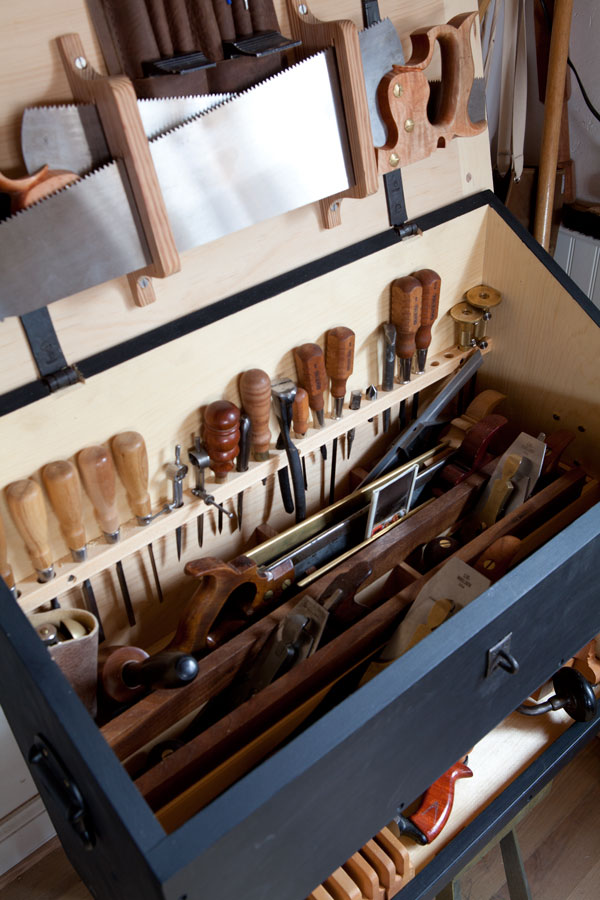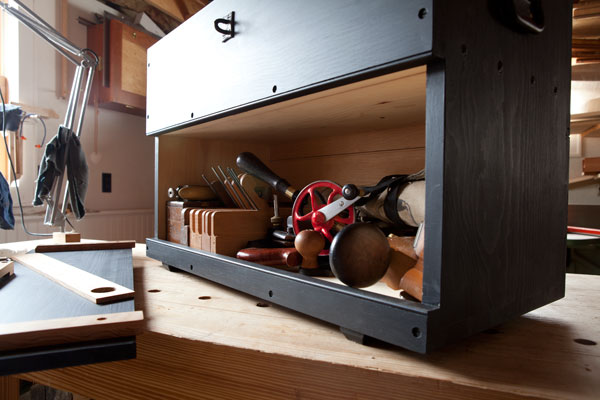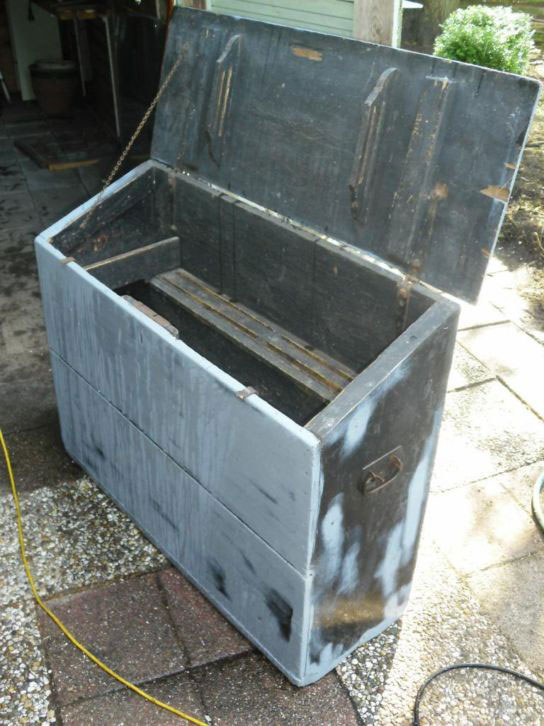We may receive a commission when you use our affiliate links. However, this does not impact our recommendations.
With the plans for the Dutch Tool Chest in the October 2013 issue of Popular Woodworking Magazine now out, several readers have been asking about how they should finish the inside surfaces of the chest.
Here’s the short answer: Don’t.
Many of the vintage tool chests that I have encountered have just bare wood inside. There is no evidence that a finish was ever applied. The downside to this approach is that the wood gets fairly dirty from contact with your hands, the tools and any lubricant on them.
I don’t mind this grungy look – but it’s an aesthetic thing. And it is the one and only “foolproof” finish I know of. So I don’t finish the insides of my tool chests.
A number of readers have asked if they should apply boiled linseed oil to the inside of their chests. I think this is a sub-optimal idea. Linseed oil has a smell that won’t dissipate when it’s applied to enclosed surfaces, such as drawers and chests. I’ve opened chests that were finished years earlier that still reek of linseed oil.
If you would like to finish the inside of your chest, I have a few recommendations.
1. Shellac. Shellac dries fast, offers good protection, is easily repaired and its smell dissipates quickly. I’ve seen many vintage chests that were finished with shellac that have survived quite well.
2. Lacquer. Lacquer offers a lot of the qualities of shellac, but it has a longer stink time. If you use lacquer, I’d let the chest sit open for a week to let the smell escape.
3. Alkyd varnish. A varnish thinned with low-odor mineral spirits makes a nice wiping varnish that can offer protection and is easy to apply. Some varnishes have some oil in them that can leave an odor. So because of that, you might want to try one of the other options.
4. Paint. Some chests are painted inside and out. My guess is that this happens later in the chest’s life when someone decides to add a coat to the outside of the chest. This is a valid option. I think it looks odd. But it’s not my chest, so go wild with some low-odor paint.
5. Water-base varnish. This modern film finish is actually a good option for people who want a “bare wood” look but want to protect the wood. Water-base finish (usually) adds little color to the wood and has almost no odor.
So here’s the bottom line: If the finish stinks, keep it off your chest.
— Christopher Schwarz
P.S. You can order the October 2013 issue of the magazine with the plans for a small and large Dutch chest from ShopWoodworking.com.
Here are some supplies and tools we find essential in our everyday work around the shop. We may receive a commission from sales referred by our links; however, we have carefully selected these products for their usefulness and quality.












I used off-white rustoleum on the inside only because the sides and shelf were from a very old faded board, and the reamainder from Menard’s “handi-panels”. So the contrast was a bit too much. And, the off-white paint helps me see what’s there. And the contrast with the “sea foam” milk paint outside is pretty nice.
This blog reminds me of a question that has come to mind each time I see any tool storage project. I have done some woodworking for many years but have not completed a lot of projects using new lumber. My question is, at what moisture content is it safe to use wood for a tool storage project? I have on several occasions left a scrap of wood laying on the cast iron table of a piece of equipment only to find a rust spot under it when I return a week or so later. Obviously the moisture in the piece of wood caused the oxidation. I want to make several tool storage racks and organizers but am concerned about the tools being rusted. Can anyone offer some guidence?
I have my dad’s (carpenter’s) tool chest which he built in (as best I can ascertain) the 1930’s. made of yellow pine (the top of the lid is a single board about 20″x38″). The whole chest is built with nailed together mitered corners! The inside has no finish. After being in a musty basement for 20 years or so, it took on that odor, but as someone else said, the tools didn’t rust! Sadly, I haven’t used it as a tool chest for the last 25 years–my wife insists on it being on permanent display as our living room coffee table! A couple of his planes, some chisels, hand saws, brace & bits, Yankee screwdriver and other handtools are among my favorites and still in regular use.
I still prefer the olde Boiled Linseed Oil with a coat of paste wax for protection and appearance. I suppose the fact that I use Kramers oil on the wooden parts of my tools also limits or neutralizes any odours?
Cape Town
It would seem that despite the fact that the wood in the chest would be absorbing moisture from the air in a humid climate like mine, once the lid is closed, all that exposed wood inside would continue to absorb any moisture left on the tools. Mine don’t rust when they’re inside the chest, even in high humidity. I won’t be finishing the inside of my chest, any help I can get from the exposed wood, I’ll take.
Also, even in the humidity, when I painted the outside with milk paint, it dried very fast, five to ten minutes a side in most cases, touch up was a nightmare. So, that wood seems to be able to take a lot of water, before it can’t.
I was going to add a coat of paste wax to the interior; now I’m having second thoughts.
Good tips on finishing.
The saw blade teeth look a little ominous when the lid is open… ouch!
Dittos to JMAW. The smell of my chest’s raw interior, along with the toolsand fabric packed into it, is a joy to be experienced every morning.
Another benefit to not finishing is the smell when you open it. Every time I open my small poplar chest I made at Roy’s I get a memory of that experience which is great. The dust sealed unfinished chest really concentrates the scent.
Any comment on burnishing via Don’s “broom handle” either with or without the wax? After getting one at HandWorks I’ve been “polissoiring” everything in sight, but wonder about what if any effect it has on oxidation etc. inside a chest.
I put a coat of shellac (Sealcoat – a very light blond, dewaxed.) I think it’s the closest thing to no finish at all, while offering some mild protection from deep penetration of dirt and grime. Plus my workshop is in a fairly damp basement, and I think the shellac provides a very little bit of a moisture barrier to partially balance the moisture barrier provided by the exterior finish. I think this helps keep the wood more stable when I move the chest between my shop (very damp) and my garage (somewhat drier.)